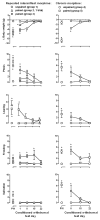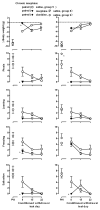Precipitated and conditioned withdrawal in morphine-treated rats
- PMID: 20127077
- PMCID: PMC3480722
- DOI: 10.1007/s00213-009-1773-3
Precipitated and conditioned withdrawal in morphine-treated rats
Abstract
Rationale: Stimuli that are paired with opioid withdrawal can themselves produce effects similar to withdrawal that might promote relapse.
Objective: This study compared precipitated and conditioned withdrawal and tested whether withdrawal is modified by clonidine or morphine.
Methods: Morphine-treated rats (10 mg/kg/12 h) received naloxone (3.2 mg/kg) in a novel environment (conditioned stimuli [CS]). Other rats received naloxone in the absence of the CS. Body weight and observable signs were used to measure withdrawal.
Results: Naloxone produced weight loss and withdrawal signs in morphine-treated rats. Following pairings of the CS and naloxone, the CS alone had effects similar to naloxone; conditioned withdrawal was greater after three naloxone/CS pairings, as compared to one, and with longer morphine treatment. Antagonist-precipitated withdrawal was greater in rats that previously were physically dependent on morphine, as compared to withdrawal in rats that were never dependent; however, conditioned withdrawal did not differ between groups. When administered concurrently with naloxone, clonidine (0.1 mg/kg) attenuated some precipitated withdrawal signs, although conditioned withdrawal was largely unchanged. Administration of 10 mg/kg of morphine before the CS alone attenuated all conditioned withdrawal signs, whereas 0.1 mg/kg of clonidine before the CS alone reduced some directly observable signs and not weight loss.
Conclusions: Conditioned withdrawal occurs rapidly and is greater with longer periods of morphine treatment or more pairings of naloxone and the CS; however, a history of physical dependence does not increase conditioned withdrawal. Modification of conditioned withdrawal by drugs might be a useful approach for treating relapse.
Figures




Similar articles
-
Discrete cues paired with naloxone-precipitated withdrawal from acute morphine dependence elicit conditioned withdrawal responses.Behav Pharmacol. 2006 May;17(3):213-22. doi: 10.1097/00008877-200605000-00002. Behav Pharmacol. 2006. PMID: 16571999 Free PMC article.
-
Quantitative evaluation of opioid withdrawal signs in rats repeatedly treated with morphine and injected with naloxone, in the absence or presence of the antiabstinence agent clonidine.J Pharmacol Toxicol Methods. 1997 Nov;38(3):117-31. doi: 10.1016/s1056-8719(97)00050-6. J Pharmacol Toxicol Methods. 1997. PMID: 9523765
-
Conditioned sucrose aversions produced by naloxone-precipitated withdrawal from acutely administered morphine.Pharmacol Biochem Behav. 1997 Dec;58(4):1003-8. doi: 10.1016/s0091-3057(97)00313-4. Pharmacol Biochem Behav. 1997. PMID: 9408206
-
Clonidine attenuates conditioned aversion produced by naloxone-precipitated opiate withdrawal.Eur J Pharmacol. 1994 Mar 11;254(1-2):59-63. doi: 10.1016/0014-2999(94)90370-0. Eur J Pharmacol. 1994. PMID: 8206117
-
Clonidine blocks acquisition but not expression of conditioned opiate withdrawal in rats.Neuropsychopharmacology. 1998 Nov;19(5):406-16. doi: 10.1016/S0893-133X(98)00036-0. Neuropsychopharmacology. 1998. PMID: 9778662
Cited by
-
Differences in withdrawal symptoms, microglia activity, and cognitive functioning in rats exposed to continuous low-dose heroin in-utero.Neurotoxicol Teratol. 2024 Sep-Oct;105:107385. doi: 10.1016/j.ntt.2024.107385. Epub 2024 Aug 23. Neurotoxicol Teratol. 2024. PMID: 39182528
-
Effects of repeated exposure to morphine in adolescent and adult male C57BL/6J mice: age-dependent differences in locomotor stimulation, sensitization, and body weight loss.Psychopharmacology (Berl). 2014 Apr;231(8):1517-29. doi: 10.1007/s00213-013-3298-z. Epub 2013 Oct 6. Psychopharmacology (Berl). 2014. PMID: 24096538 Free PMC article.
-
Reduced Taurine Synthesis Underlies Morphine-Promoted Lung Metastasis of Triple-Negative Breast Cancer.Cancers (Basel). 2025 Mar 24;17(7):1086. doi: 10.3390/cancers17071086. Cancers (Basel). 2025. PMID: 40227606 Free PMC article.
-
Drug-motivated behavior in rats with lesions of the thalamic orosensory area.Behav Neurosci. 2016 Feb;130(1):103-13. doi: 10.1037/bne0000114. Epub 2015 Dec 14. Behav Neurosci. 2016. PMID: 26653714 Free PMC article.
-
Bilateral lesions of the thalamic trigeminal orosensory area dissociate natural from drug reward in contrast paradigms.Behav Neurosci. 2012 Aug;126(4):538-50. doi: 10.1037/a0028842. Epub 2012 Jun 11. Behav Neurosci. 2012. PMID: 22687147 Free PMC article.
References
-
- Azar MR, Jones BC, Schulteis G. Conditioned place aversion is a highly sensitive index of acute opioid dependence and withdrawal. Psychopharmacology. 2003;170:42–50. - PubMed
-
- DiStefano PS, Brown OM. Biochemical correlates of morphine withdrawal. 2. Effects of clonidine. J Pharmacol Exp Ther. 1985;233:339–344. - PubMed
-
- Galligan JJ, Burks TF. Centrally mediated inhibition of small intestinal transit and motility by morphine in the rat. J Pharmacol Exp Ther. 1983;226:356–361. - PubMed
MeSH terms
Substances
Grants and funding
LinkOut - more resources
Full Text Sources

